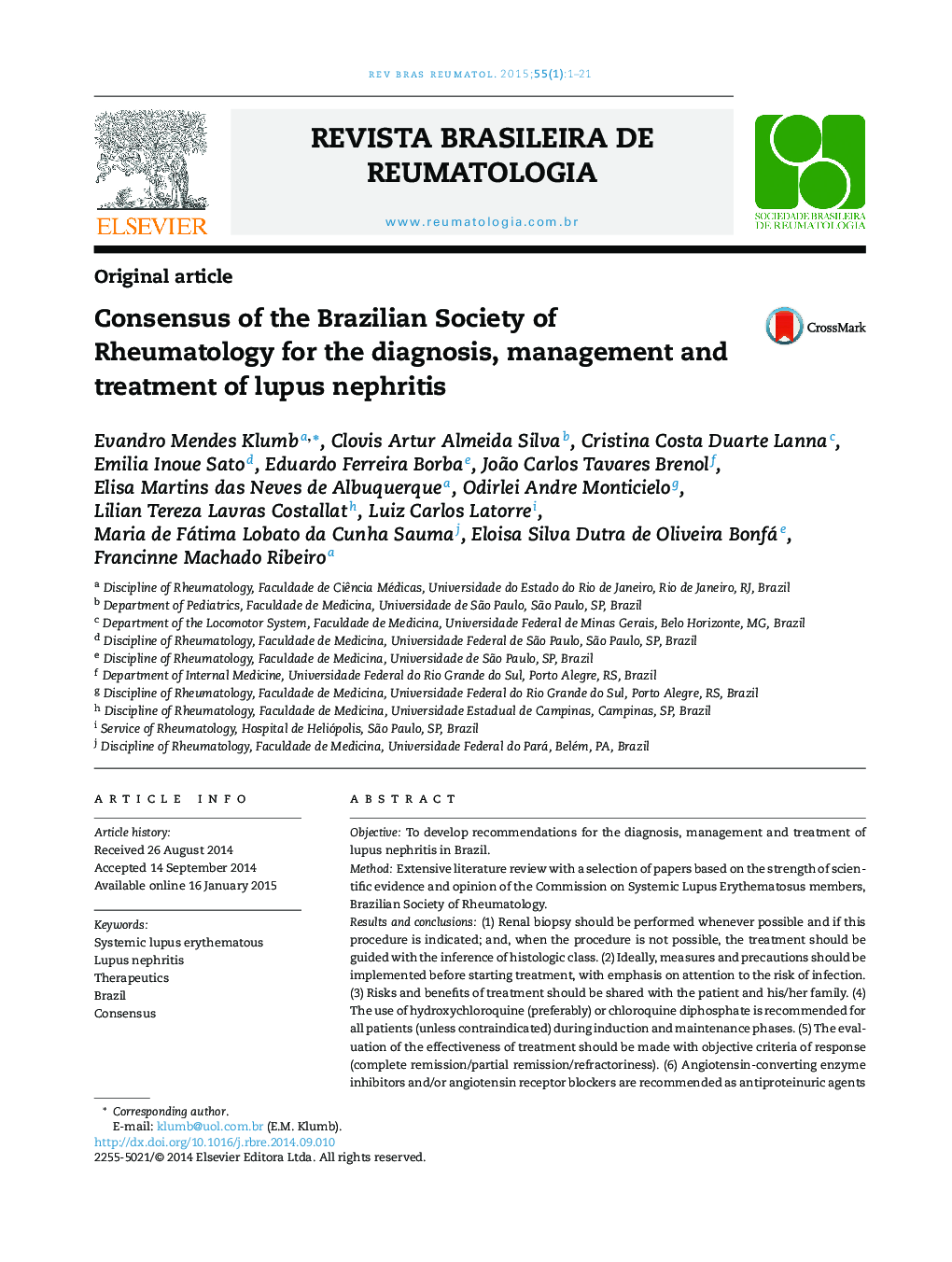| کد مقاله | کد نشریه | سال انتشار | مقاله انگلیسی | نسخه تمام متن |
|---|---|---|---|---|
| 3385211 | 1220579 | 2015 | 21 صفحه PDF | دانلود رایگان |
ObjectiveTo develop recommendations for the diagnosis, management and treatment of lupus nephritis in Brazil.MethodExtensive literature review with a selection of papers based on the strength of scientific evidence and opinion of the Commission on Systemic Lupus Erythematosus members, Brazilian Society of Rheumatology.Results and conclusions(1) Renal biopsy should be performed whenever possible and if this procedure is indicated; and, when the procedure is not possible, the treatment should be guided with the inference of histologic class. (2) Ideally, measures and precautions should be implemented before starting treatment, with emphasis on attention to the risk of infection. (3) Risks and benefits of treatment should be shared with the patient and his/her family. (4) The use of hydroxychloroquine (preferably) or chloroquine diphosphate is recommended for all patients (unless contraindicated) during induction and maintenance phases. (5) The evaluation of the effectiveness of treatment should be made with objective criteria of response (complete remission/partial remission/refractoriness). (6) Angiotensin-converting enzyme inhibitors and/or angiotensin receptor blockers are recommended as antiproteinuric agents for all patients (unless contraindicated). (7) The identification of clinical and/or laboratory signs suggestive of proliferative or membranous glomerulonephritis should indicate an immediate implementation of specific therapy, including corticosteroids and an immunosuppressive agent, even though histological confirmation is not possible. (8) Immunosuppressives must be used during at least 36 months, but these medications can be kept for longer periods. Its discontinuation should only be done when the patient could achieve and maintain a sustained and complete remission. (9) Lupus nephritis should be considered as refractory when a full or partial remission is not achieved after 12 months of an appropriate treatment, when a new renal biopsy should be considered to assist in identifying the cause of refractoriness and in the therapeutic decision.
ResumoObjetivoElaborar recomendações para o diagnóstico, manejo e tratamento da nefrite lúpica no Brasil.MétodoRevisão extensa da literatura com seleção dos artigos com base na força de evidência científica e opinião dos membros da Comissão de Lúpus Eritematoso Sistêmico da Sociedade Brasileira de Reumatologia.Resultados e conclusões1) A biópsia renal deve ser feita sempre que possível e houver indicação e quando não for possível, o tratamento deve ser orientado com base na inferência da classe histológica. 2) Devem ser implementados medidas e cuidados idealmente antes do início do tratamento, com ênfase na atenção ao risco de infecção. 3) Devem-se compartilhar riscos e benefícios do tratamento com os pacientes e familiares. 4) O uso da hidroxicloroquina (preferencialmente) ou difosfato de cloroquina é recomendado para todos os pacientes (exceto contraindicação) durante as fases de indução e manutenção. 5) A avaliação da eficácia do tratamento deve ser feita com critérios objetivos de resposta (remissão completa/remissão parcial/refratariedade). 6) Os inibidores da enzima conversora da angiotensina ou bloqueadores dos receptores da angiotensina são recomendados como antiproteinúricos para todos os pacientes (exceto contraindicação). 7) A identificação de sinais clínicos e/ou laboratoriais sugestivos de GN proliferativa ou membranosa deve indicar início imediato de terapia específica incluindo corticosteroides e agente imunossupressor, mesmo que não seja possível comprovação histológica. 8) O tempo de uso dos imunossupressores deve ser no mínimo de 36 meses, mas eles podem ser mantidos por períodos mais longos. A sua suspensão só deve ser feita quando o paciente atingir e mantiver remissão completa sustentada. 9) Deve-se considerar NL refratária quando a remissão completa ou parcial não for alcançada após 12 meses de tratamento adequado, quando uma nova biópsia renal deve ser considerada para auxiliar na identificação da causa da refratariedade e decisão terapêutica.
Journal: Revista Brasileira de Reumatologia (English Edition) - Volume 55, Issue 1, January–February 2015, Pages 1–21
